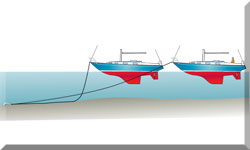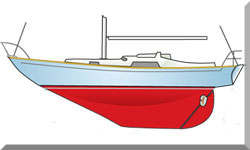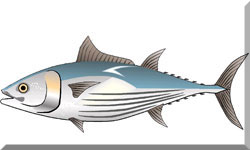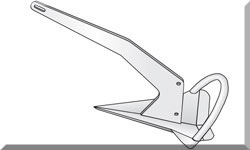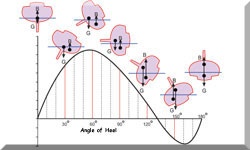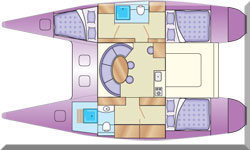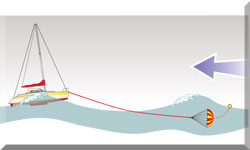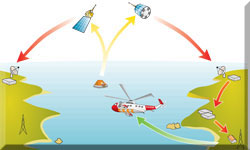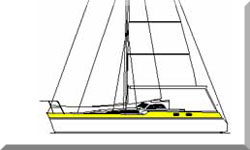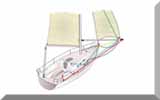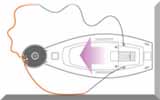- Home
- Choosing Accessories
- Boat Fridge
Don't Lose Your Cool with
Your Boat Fridge
It's often said that a top-opening boat fridge is more efficient than the front-opening type, because the cold doesn't 'fall out' when you take the lid off. True, but in my experience, whatever you need will be at the bottom, which means that half the stuff will have to come out before you can get at it.
Jump to:
Hot arms will displace the cold air and the stuff you've taken out will start to cool. In a front opening fridge, all the goodies are on shelves - easy to find and remove, so the door can quickly be closed.
I've not done the experiment, but I'll bet there's not much in it.
What is important is the quality and thickness of the insulation - at least 100mm of it - and the condition of the seal at the lid or door.
Either way, next time your grab a cool beer from your boat fridge, spare a thought for Robert Boyle who started it all back in 1662. Boyle recognised that if you mess around with the pressure and volume of a gas, its temperature will change - and that explains a lot of what goes on inside a fridge.
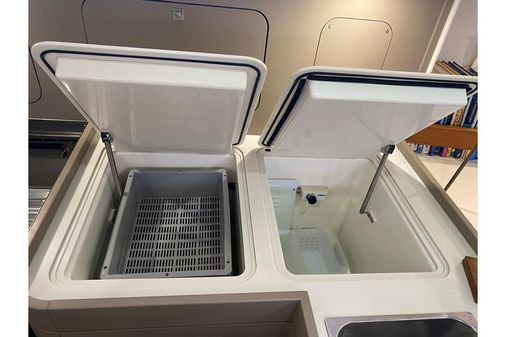 A top-opening fridge/freezer unit
A top-opening fridge/freezer unitHow Does A Boat Fridge Work?
The component parts of a boat fridge are a compressor, a condenser, an expansion valve and a cold plate. They work together to produce the following cycle of events:~
- The compressor compresses the refrigerant gas, reducing its volume and thereby raises its temperature, and pumps it along to the condenser.
- The condenser allows the refrigerant to dissipate the heat arising from the change in pressure.
- As it cools, the refrigerant condenses into liquid form and flows through the expansion valve.
- Here, the liquid refrigerant flows from a high pressure zone to low pressure zone, causing it to expand, vaporise and cool rapidly as it enters the cold plate.
- The coils inside the cold plate allow the refrigerant to absorb heat from the surrounding air, which is of course the inside of the boat fridge.
- The heat-bearing gas returns to the compressor and the cycle is repeated, further lowering the temperature of the boat fridge.
- When the temperature has dropped to the temperature set on the thermostat, the power to the compressor is turned off until such time as it has fallen to the 'start-up' temperature.
The system performance depends on the characteristics of the individual components, some of which are more suited for certain applications than others.
The Main Components of a Boat Fridge...
The Compressor
This is either powered by the boat's electrical system or driven by a belt from the main engine. Electrically powered compressors are normally of the diaphragm type, although very large units may be of a piston design.
This latter type, resembling a reciprocating engine, is more costly to manufacture but can be stripped and serviced by a competent mechanic, whereas the diaphragm type is almost invariably a sealed unit which must be replaced when it fails.
Due to their compactness, efficiency and quiet operation, nearly all proprietary 'packaged units' incorporate a diaphragm compressor. But piston or diaphragm, both types have a healthy appetite for electricity.
Engine driven versions, developed from car air-conditioning units, are engaged through an electromagnetic clutch, either automatically or simply by throwing a switch. They're very powerful and of course make no demand (other than a few milliamps for the thermostat) on the boat's electrical system.
But they do depend on running the main engine - typically an hour a day in a well set up system - which, on a sailing vessel, you may not always want to do.
The Condenser
This, a heat exchanger, will be one of two types - air cooled or seawater cooled.
Air cooled units are the simpler, more elegant solution and if installed below the waterline where the bilge air is at a similar temperature to the sea, they can be remarkably efficient - particularly so if a steady stream of cool air is wafted over them by a small fan.
But they can struggle a bit in hot climates where the difference between the ambient air temperature and that required inside the fridge may not be enough to dissipate the heat in the refrigerant gas. In these conditions, and most definitely if the cooling unit is installed in the engine room, a seawater type will be required.
A circulation pump draws in cooling water from outside the boat and, water being a much better conductor of heat than air, will carry away the heat more effectively.
An innovative approach by one manufacture manages to achieve seawater cooling without an electrically driven pump. A special skin fitting replaces the one normally fitted at the galley sink. This contains a spiral heat exchanger, through which the refrigerant gas passes transferring its heat to the seawater.
The slightest movement of the boat, even when tied-up alongside, is enough to pump away the heat. Clever stuff.
The Cold Plate
Again there are two types - the basic evaporator plate and the cold storage 'eutectic' plate.
The basic evaporator plate cools down quickly but equally quickly, warms up again. Consequently the thermostat will be regularly kicking the compressor in and out - a 'constant cycling' system. In hot climates the compressor may be running for 45 minutes or so in every hour, so the current drain will be high.
The cold storage 'eutectic' plate differs from the basic evaporator plate in that the coils are immersed in a liquid that freezes and melts at minimum temperature - a 'eutectic' liquid. This takes a bigger effort to cool the plate down, normally done in one hit by an oversized compressor, but it then retains its 'cool' for longer, gradually dispensing through a state of being frozen solid to partially thawed out.
Clearly this is the type of cold plate to use with an engine driven compressor, and if using the Automatic Start-Up system described below.
The Automatic Start-Up (ASU) System
This system senses when surplus electrical energy is available, either from the alternator, solar panels or wind generator.
It then speeds up the compressor to rapidly freeze the eutectic liquid in the cold plate and keeps it frozen until surplus energy is no longer available, at which point it stops the compressor until either:
- the cold plate falls to a predetermined temperature, whereon the compressor restarts in a low speed, low current mode to maintain the temperature at that level, or
- more surplus energy becomes available, whereon it restarts the compressor in high speed mode, freezing down the cold plate again.
Installation
If you're installing a fridge in a boat that doesn't already have one, you'll have a few things to consider...
Location
You'll want to think about airflow around the unit, especially for air-cooled condensers. Stuffing it into a tiny, unventilated locker is a recipe for an overheated (and underperforming) fridge. Ideally, below the waterline in a well-ventilated bilge area can be surprisingly efficient, as the air temperature there tends to be cooler and more stable, much like the sea itself.
Electrical Supply
Then there's the electrical side of things. These fridges, especially during startup, can draw a fair bit of current, so you'll need to make sure your boat's electrical system can handle it. This means using appropriately sized wiring – too thin, and you risk voltage drop and overheating (definitely not good!). Don't skimp on fuses or circuit breakers either. They're your first line of defense against electrical gremlins. Think of them like little guardians protecting your system. For the fridge itself, you'll likely need a dedicated circuit run directly from your battery bank or a well-protected distribution panel.
Plumbing
If you're considering a seawater-cooled system, you'll be dealing with plumbing. This usually involves a dedicated intake through a skin fitting (that clever one we mentioned earlier, or a more traditional setup with a pump), hoses, and connections to the condenser. Making sure these connections are secure and won't leak is paramount – you definitely don't want seawater where it shouldn't be! For the electrical side of a seawater-cooled system with a pump, you'll need to factor in the pump's power draw as well.
Noise
Mounting the compressor is another often-overlooked detail. Compressors vibrate, and that vibration can translate into noise throughout your boat. Using rubber mounts or vibration-dampening pads can make a big difference in keeping things quiet and peaceful.
DIY or getting a professional involved?
Finally, a common question is whether to tackle the fridge installation yourself or call in a professional. This really depends on your skill level, the complexity of the system, and your comfort level with electrical and plumbing work.
DIY installation can save you money on labor, but it requires a good understanding of of electrical systems, proper wiring techniques, and the ability to follow instructions carefully. Mistakes can be costly and even dangerous. If you're only replacing an existing unit like-for-like, it might be more straightforward. However, installing a completely new system, especially one with a seawater-cooled condenser, is a more involved process.
Professional installation ensures the job is done correctly and often comes with a warranty on the installation itself. Marine refrigeration technicians have the expertise and tools to handle the intricacies of these systems. While it's more expensive upfront, it can save you time, frustration, and potential problems down the line. Factors to consider include the complexity of the installation, your own technical skills, and the value of your time. For critical systems like refrigeration on a long voyage, peace of mind can be priceless.
Sizing & Power Consumption
Now that you know where it might go, the next logical question is, "What size fridge do I actually need, and how much juice is this thing going to suck out of my batteries?" These are critical questions for any boat owner planning an extended cruise or even a weekend getaway.
When it comes to sizing, a good rule of thumb is to think about the number of people you typically have on board and the duration of your trips. For a weekend for two, a smaller 30-50 litre fridge might suffice. For a family on a week-long adventure, you'll likely need something in the 80-130 litre range or even larger. Consider also how much fresh food versus frozen food you typically carry. If you're a keen angler or plan on storing a lot of frozen meals, a larger unit with a dedicated freezer compartment might be necessary.
Calculating power consumption can seem a bit daunting, but understanding the basics can save you from unexpected flat batteries. The key factors are the compressor's amp draw (usually listed in the specifications), the duty cycle (how often the compressor runs), and the insulation quality. A well-insulated fridge in a cool environment will have a lower duty cycle than a poorly insulated one in a warmer part of the boat.
Let's say your compressor draws 5 amps and, on average, runs for 30 minutes out of every hour (a 50% duty cycle).
That means it consumes 5 amps x 0.5 hours = 2.5 amp-hours. Over 24 hours, that's 2.5 x 24 = 60 amp-hours.
This is a simplified example, and real-world consumption can vary greatly. Factors like frequent door openings, the temperature of food being loaded, and ambient temperature all play a role.
Daily Amp-Hour Consumption ≈ (Compressor Amp Draw) x (Average Daily Run Time in Hours)
Fridge Type & Size (Approx. Internal Volume)
Typical Daily Amp-Hour Consumption (12V System)
Notes
Small Top-Loading (30-50 Litres)
25 - 40 Ah
Generally more efficient due to less cold air loss. Good for weekend trips or smaller boats.
Medium Top-Loading (50-80 Litres)
35 - 60 Ah
Suitable for couples or smaller families on longer trips. Efficiency still generally good.
Large Top-Loading (80+ Litres)
50 - 80+ Ah
Can accommodate larger groups or longer trips. Power consumption can be higher, especially in warmer climates.
Small Front-Opening (30-50 Litres)
30 - 50 Ah
Convenience of shelves but can lose more cold air when opened.
Medium Front-Opening (50-80 Litres)
45 - 70 Ah
Popular for ease of access. Look for well-insulated models to minimize power draw.
Large Front-Opening (80+ Litres)
60 - 90+ Ah
Offers the most storage but typically has the highest power consumption. Efficient models are crucial for off-grid boating.
Eutectic/Holding Plate Systems (Size Varies)
40 - 70+ Ah (for the initial freeze cycle)
Can have lower average daily consumption once the plate is frozen, as the compressor runs less frequently. Higher initial draw.
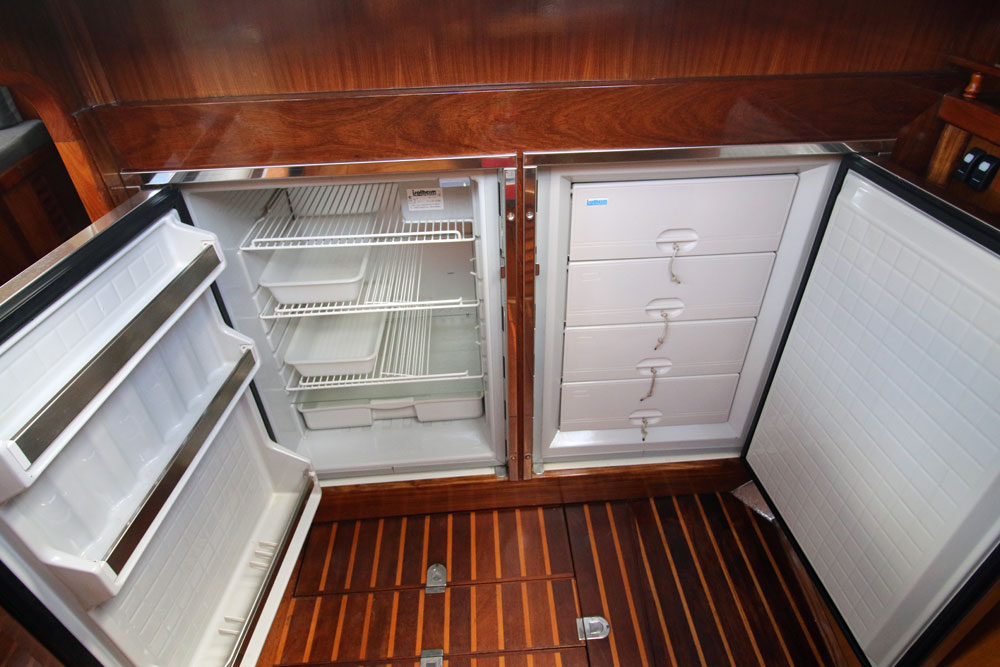 A double-door Isotherm stainless steel fridge and freezer
A double-door Isotherm stainless steel fridge and freezerImportant Considerations:
- Climate: Fridges operating in warmer climates will generally consume more power.
- Insulation: Higher quality and thicker insulation will lead to lower power consumption.
- Thermostat Setting: Lower temperature settings will increase power draw.
- Door Openings: Frequent and prolonged door openings significantly increase power consumption.
- Compressor Efficiency: Different compressors have varying levels of efficiency. Look for models with efficient compressors (e.g., Danfoss/Secop BD series)*.
* The market for 12V marine refrigeration is quite diverse, and navigating the options can be overwhelming. While we need to be careful about appearing biased, we can certainly provide some general guidance.
Reputable brands often have a track record of reliability and good customer support. Factors to consider when comparing models include efficiency ratings (how many amp-hours per day they typically consume), noise levels (some compressors are significantly quieter than others), build quality (especially important in the harsh marine environment), special features (like digital thermostats, low-voltage protection, or integrated ice makers), and of course, price.
For example, some brands are known for their robust and efficient Danfoss/Secop compressors, which are widely regarded in the marine industry. Others might focus on innovative cooling technologies or unique space-saving designs.
Saving Energy
Beyond just good insulation, there are several ways boat owners can minimize their fridge's energy consumption:
- Think about how you load your fridge. Allowing for some airflow around the contents helps the cold air circulate more effectively. Overpacking can block airflow and make the fridge work harder.
- Minimizing door openings is another big one. Every time you open the door, cold air escapes and warm, moist air enters, forcing the compressor to run longer to cool things down again. Planning what you need to take out before you open the door can make a difference.
- Pre-cooling food before you put it in the fridge also reduces the initial cooling load. Putting a warm six-pack in will make the fridge work much harder than if you let it chill in a bucket of seawater first!
- Finally, using fridge organization solutions like baskets and dividers can help you find things quickly and minimize the time the door is open.
Cost & Reliability
Let's face it, the bottom line matters. Boat owners will want to know the range of costs for different types and sizes of 12V refrigeration systems. This should include not just the unit itself but also potential additional expenses like installation materials (wiring, hoses, etc.) and professional installation fees if they choose that route.
The price range for a basic 12-volt, 50-litre top-loading fridge for a boat can vary depending on the brand and features. Generally, you can expect to pay between $300 and $1,100:
- Budget-friendly options: Around $300–$500, such as Alpicool models.
- Mid-range options: Around $600–$900, offering better insulation and energy efficiency.
- High-end options: $1,000 or more, like Isotherm models, which are known for their durability and advanced features.
For a larger, high-efficiency front-opening fridge with a dedicated freezer, the price range typically starts around $1,000 and can go up to $3,000 or more, depending on the brand, size, and features:
- Mid-range options: Around $1,000–$2,000, offering good energy efficiency and reliable performance.
- High-end options: $2,000 and above, such as models from Isotherm or Dometic, which often include advanced features like digital controls, superior insulation, and dual-zone temperature settings.
While lifespan can vary depending on usage and maintenance, but with proper care, a good quality marine fridge compressor can last anywhere from 5 to 10 years or even longer.
Troubleshooting & Maintenance
So, you've got your fridge installed and humming away nicely. But what happens when it stops humming? Knowing some basic troubleshooting and preventative maintenance can save you a lot of headaches (and potentially spoiled food!).
Common problems can range from the simple (a tripped circuit breaker or a loose connection) to the more complex (a refrigerant leak or a faulty compressor). If your fridge isn't cooling properly, the first things to check are the power supply (is it getting power?), the thermostat setting (is it set correctly?), and any obvious obstructions to airflow around the condenser. Strange noises like excessive rattling or a continuous high-pitched whine could indicate a problem with the compressor or fan. Excessive cycling (the compressor turning on and off frequently) might point to poor insulation, a door seal issue, or a partially blocked condenser.
Preventative maintenance is all about keeping things running smoothly in the long term. Regularly cleaning the condenser coils (if it's air-cooled) is crucial, as dust and debris can significantly reduce its efficiency. Check the door or lid seal periodically to ensure it's clean and making good contact all the way around. A worn or damaged seal lets cold air escape and forces the compressor to work harder. For seawater-cooled systems, checking for any signs of corrosion or blockages in the water lines is important.
Basic Troubleshooting Checklist for 12-Volt Fridges
1. Power Supply Check:
- Confirm the fridge is properly connected to the power source.
- Check the boat's battery voltage – it should typically be around 12-13 volts. A low battery might prevent the fridge from functioning.
2. Fuses and Breakers:
- Inspect the fridge's fuse and replace it if it's blown.
- Ensure the circuit breaker for the fridge is not tripped.
3. Wiring and Connections:
- Check for loose or corroded connections at the fridge and power source.
- Look for damaged or frayed wires that could interrupt the power supply.
4. Temperature Settings:
- Verify the thermostat settings to ensure it's not accidentally turned off or set too low.
5. Ventilation:
- Ensure the fridge has adequate airflow around the cooling unit, as poor ventilation can cause inefficiency or overheating.
6. Compressor and Fans:
- Listen for unusual noises from the compressor or fan – this might indicate a mechanical issue.
- Confirm that the fan is functioning and not obstructed by debris.
7. Cooling Unit:
- Check the cooling unit for signs of frost buildup, which could indicate a problem with defrosting.
8. External Power Test:
- If possible, connect the fridge to an alternate 12-volt power source (e.g., another battery) to rule out a power supply issue.
9. Owner's Manual:
- Consult the fridge's manual for specific troubleshooting tips and error codes that might be displayed on the control panel.
10. Contact a Professional:
- If the above steps don't resolve the issue, it might be time to consult a marine electrician or fridge technician.
Recent Articles
-
RM Sailboats: Plywood-Epoxy Performance Cruisers for Offshore
Oct 30, 25 07:37 AM
RM Yachts offers a unique blend of speed, comfort, and safety with their innovative plywood-epoxy hulls. An expert sailor's guide to the French-built performance cruisers. -
Rival Yachts: A Guide to These Legendary British Bluewater Cruisers
Oct 30, 25 02:52 AM
Explore the legacy of Rival Yachts, from the design philosophy of founder Peter Brett to the key models like the Rival 34, 36, 38 & 41. A complete guide for sailors and liveaboards. -
Pearson Sailboats: A Legacy of Fiberglass Innovation
Oct 30, 25 02:51 AM
Explore the history, design, and enduring legacy of Pearson Sailboats, pioneers in fiberglass sailboat construction.

